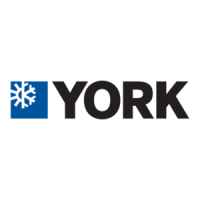YORK INTERNATIONAL
62
FORM 150.62-NM7 (103)
The subcooling temperature of each system can be
cal cu lat ed by recording the temperature of the liquid
line at the outlet of the condenser and sub tract ing it from
the liquid line saturation tem per a ture at the liquid stop
valve (liquid line saturation temp. is con vert ed from a
tem per a ture/pres sure chart).
Example:
Liquid line pressure = 102°F
202 PSIG converted to - 87°F
minus liquid line temp.
Subcooling = 15°F
The subcooling should be adjusted to 15°F at de sign
conditions.
! 1. Record the liquid line pressure and its cor re -
spond ing temperature, liquid line tem per a ture
and subcooling below:
SYS 1 SYS 2
Liq Line Press = _______ _______PSIG
Saturated Temp = _______ _______°F
Liq Line Temp = _______ _______°F
Subcooling = _______ _______°F
After the subcooling is verifi ed, the suction su per heat
should be checked. The superheat should be checked
only af ter steady state operation of the chiller has been
es tab lished, the leaving water tem per a ture has been pulled
down to the required leav ing water tem per a ture, and the
unit is running in a fully loaded con di tion. Correct su per heat
setting for a sys tem is 10°F - 15°F (5.56°C - 8.33°C) 18"
(46 cm) from the cooler.
Superheat should typically be set for no less than
10°F with only a single compressor running on a
circuit. The su per heat is cal cu lat ed as the dif fer ence
be tween the ac tu al tem per a ture of the re turned re frig -
er ant gas in the suc tion line en ter ing the com pres sor and
the tem per a ture cor re spond ing to the suction pres sure
as shown in a stan dard pres sure/tem per a ture chart.
Example:
Suction Temp = 46°F
minus Suction Press
60 PSIG converted to Temp - 34°F
Superheat = 12°F
When adjusting the expansion valve (TXV only), the
ad just ing screw should be turned not more than one
turn at a time, al low ing suf fi cient time (ap prox i mate ly 15
min utes) be tween ad just ments for the system and the
ther mal ex pan sion valve to re spond and stabilize.
The EEV is non-adjustable. Su per heat
setpoint is programmable from the
keypad.
Assure that su per heat is set at a minimum of 10°F (5.56°C)
with a single compressor running on each cir cuit.
! 2. Record the suc tion tem per a ture, suction pres sure,
suc tion sat u ra tion temperature, and su per heat of
each system be low:
SYS 1 SYS 2
Suction temp = _______ _______°F
Suction Pressure = _______ _______PSIG
Saturation Temp = _______ _______°F
Superheat = _______ _______°F
LEAK CHECKING
! 1. Leak check compressors, fi ttings, and pip ing to
ensure no leaks.
If the unit is functioning satisfactorily during the ini tial
op er at ing period, no safeties trip and the com pres sors
cycle to control water temperature to setpoint, the chill er
is ready to be placed into operation.
Installation
! 3. Allow the compressor to run a short time, being
ready to stop it immediately if any unusual noise
or ad verse conditions develop.
! 4. Check the system operating parameters. Do this
by selecting various displays such as pressures
and temperatures and comparing these read ings
to pressures and temperatures taken with man-
i fold gauges and temperature sensors.
! 5. With an ammeter, verify that each phase of the
con dens er fans and compressors are within the
RLA as listed under Electrical Data.
CHECKING SUPERHEAT AND SUBCOOLING
The subcooling and superheat should always be
checked when charg ing the system with re frig er ant.
When the refrigerant charge is correct, there will be no
vapor in the liquid sight glass with the sys tem op er at ing
under full load conditions, and there will be 15°F (8.34°C)
subcooled liquid leaving the condenser.
An overcharged system should be guarded against.
The temperature of the liquid refrigerant out of the con-
dens er should be no more than 18°F (10°C) subcooled
at de sign conditions.

